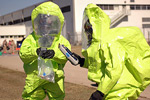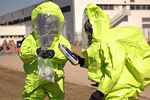
Contemporary Issues in Process Hazard Analysis
PHA should ensure that employee and contractor training is in alignment with the composition of the workforce and technology.
- By G. C. Shah
- Dec 01, 2009

Soldiers participating in toxic industrial chemical protection and detection equipment training at Fort Hood, Texas. Image via The U.S. Army.
Process Hazard Analysis (PHA), a regulatory requirement under OSHA's 29 CFR 1910.119(e), is a collection of methodologies to address process hazards. Societal and technological changes are affecting sources, intensity, and frequency of hazards. For instance, digital controls and smart instruments have reduced maintenance requirements inherent with analog instruments.
It is reasonable to state that digital controls, in general, reduce maintenance-related hazards of the analog systems. However, as may be anticipated, they present a different set of safety issues. Similarly, changes in today's industrial workforce present hazards that are different from those presented a decade or so ago. Th us, although PHA methodologies remain essentially unchanged, their emphasis on sources and intensities of hazards changes. Proper consideration of societal and technological changes ("soft" and "hard" issues) will help ensure that a PHA identifies and addresses hazards effectively.
This paper discusses six contemporary issues that significantly affect the nature and intensity of hazards:
- Business volatility
- Process instrumentation, control, and safety systems
- Database management
- Process developments
- Changing workforce
- Security and infrastructure
- Regulatory issues
Business Volatility
In some sense, the business climate always keeps changing. However, recent trends in mergers, acquisitions, divestitures, and globalization tend to enhance business volatility. What does business volatility have to do with PHA? Business changes could affect safety in numerous ways.
For instance, assume company A shares its flare with companies B and C. Further assume company A, because of a changing market environment, has to change its operations frequently. This will affect flare operations. If proper safeguards are not incorporated into design and/or administrative procedures, a mishap at company A could jeopardize safety at other plants. Cost-cutting measures made in response to market pressures sometimes may be a detriment to a company's safety, health, and environmental efforts. As refineries and chemical plants change feedstocks, previously nonexistent hazards could become crucially important. Although Management Of Change (MOC) is intended to address hazards before any change is implemented, in practice, however, there is oft en time pressure to complete MOC as quickly as possible. PHA should ensure an ongoing and robust MOC is in place.
An effective PHA would thoroughly consider potential impacts on safety from business changes. PHA should ensure that adequate and robust administrative and control safeguards (engineering safeguards) are in place to minimize occurrences and the spread of unsafe events.
Process Instrumentation, Control, and Safety Systems
Process controls and instruments have their own life cycles; birth, growth, maturation, decline, and obsolescence. Pneumatic systems were followed by electrical systems and then by digital systems. Today, most instruments are smart (digital systems with self-diagnostics and communication capabilities) with fieldbus/protocols (e.g., HART) as a means of data communication.
Digitization has practically eliminated inherent problems of pneumatics and electrical systems (drift of analog instruments, problems with the quality of air supply, signal accuracy, and others) and enhanced safety in a number of ways, including substantially reduced maintenance, early detection of problems, and implementation of complex safety functions. Some Foundation fieldbus transmitters can even detect plugged impulse lines, a common problem in some applications.
Despite all of these benefits, smart instruments are not totally immune to the problems that can impair safety. For instance, using instruments outside their turndown ratio (operating range), lack of regular maintenance, and improper applications could lead to unsafe situations. Wireless devices are gaining popularity, but their applications in safety-critical applications should be approached with considerable caution because these devices are still in the relatively early stages of development.
This is not to suggest that new technologies should not be applied. In fact, it is the newer technologies, such as smart instruments and communication protocols, that have contributed to improved safety in recent years. Recently, several organizations have been pursuing certification of their safety-instrumented systems. These third-party certifications, based on IEC 61511 (also ANSI/ ISA 84.01), are helpful in ensuring safe operation and high reliability through the life of an instrument and control loops.
Database Management
A typical PHA generates a wealth of information regarding hazards and recommended corrective actions. Today, a number of soft ware packages are available that enhance auditable documentation, analysis, and availability of data (e.g., search and sort functions). These packages contain multiple functionalities, such as data check, data encryption, statistical analyses and graphing, and some others. The packages are also amenable to Web implementation.
Process Developments
As may be expected, different processes pose different hazards. In a sense, PHA is an assessment of hazards presented by a process, and therefore it is always an issue. The reasoning behind considering process developments as an issue is that as new processes are developed, PHA should take into consideration that workers have scant experience with the new process, and this may lead to unsafe events. Conversely, projects that involve technologies that are already in use by the company may, generally, pose less risk.
This issue of process developments may also be called "uncharted territory."
Changing Workforce
Continual craft and safety training of workers is almost always assumed for a PHA (i.e., it is assumed that an organization has mechanisms to train its workers). The type of training should keep pace with the changes in technology, as well as changes in the composition of the workforce.
Security and Infrastructure
Aft er the 9/11 tragedy, a number of organizations including the American Chemistry Council and The Center for Chemical Process Safety have developed guidelines for identifying and evaluating a plant's security vulnerabilities. The U.S. Department of Homeland Security has promulgated standards for chemical facilities' anti-terrorism measures (6 CFR 27); the standards became effective on June 8, 2007.
The regulation covers facilities that handle one or more chemicals on the Chemicals Of Interest List (6 CFR 27, Appendix A) above the threshold or screening quantities. A number of chemical companies have conducted Security and Vulnerability Analysis (SVA) of their sites and developed Site Security Plans (SSPs). Briefly, SVA entails a review of the chemicals, processes, and avenues by which these chemicals can fall into the hands of groups intent on causing large-scale catastrophe or supply disruptions.
In parallel with chemical security, cyber security has also received considerable attention. A number of vulnerabilities exist, including but not limited to corrupted soft ware and data files, viruses, worms, denial-of-service, and Trojan horses. Just as in PHA, risks and consequences are prioritized so that mitigation measures can be developed. Additionally, SVA — just as in PHA — also may involve Quantitative Risk Assessment (QRA).
Regulatory Issues
Compliance with existing health, safety, and environmental regulations is an integral part of PHA. Focus areas of regulations change in response to local and global events and public demands. For instance, based on accumulated data and comments received, OSHA promulgated a new standard setting exposure limits for hexavalent chromium (a PEL of 5 micrograms/m3) in 2006, much lower than the previous exposure limit of 100 micrograms/m3. Similarly, Highly Reactive VOC regulations from Texas Commission on Environmental Quality are examples of a shift in regulatory focus.
PHA has to ensure the project is in compliance with federal, state, and local regulations. This would include equipment design, compliance testing where applicable, sampling, recordkeeping, and reporting.
This article originally appeared in the December 2009 issue of Occupational Health & Safety.
About the Author
G.C. Shah works for Mustang Engineering L.P. of Houston, Texas. The company, a subsidiary of international
energy services company John Wood Group PLC, is a
service provider to the global oil, gas, chemical, and manufacturing
industries.